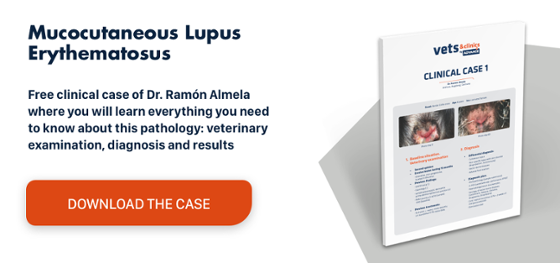Sarcoptic mange: diagnostic value of the pinnal-pedal reflex
Sarcoptic mange is a parasitic disease caused by the mite Sarcoptes scabiei var. Canis. It manifests as intense, pruritic dermatitis that can produce type I, III and IV hypersensitivity reactions in dogs. In many cases, a small number of mites cause extreme pruritus, which implies the direct cause of the clinical manifestations may be the hypersensitivity reaction.
What is sarcoptic mange?
Sarcoptic mange is a parasitic disease caused by the mite Sarcoptes scabiei var. Canis. It manifests as intense, pruritic dermatitis that can produce type I, III and IV hypersensitivity reactions in dogs. In many cases, a small number of mites cause extreme pruritus, which implies the direct cause of the clinical manifestations may be the hypersensitivity reaction.
Sarcoptes mites measure between 200 and 400 µm and only the front legs are visible, with long, unarticulated peduncles and terminal suction cups. They feed on skin detritus on the surface of the epidermis for most of their life cycle, which lasts 12 to 15 days. Finally, pregnant females dig tunnels in the stratum corneum to lay their eggs. Once hatched, the larvae move back up to the surface.
Sarcoptes are transmitted between dogs by direct contact. It rarely infests humans and is only temporary when it does. Infested dogs will display intense scratching, as well as licking and biting the worst affected areas, which are usually located around the ears, eyes, groin and elbows.
Sarcoptic mange: diagnosis
Diagnosis can be complicated, as there are often only a very few mites compared to the degree of pruritic reaction produced. So, it can be hard to observe the mites directly in skin scrapings. In addition, the clinical signs may be masked by other treatments that have already been applied for the pruritus.
At least five different areas containing the most recent lesions must be selected for a correct skin scraping. Given that up to 75% of skin scrapings can yield a negative result even when mites are present, negative skin scrapings should never be used to rule out Sarcoptes.
An ELISA serology test for IgG antibodies to Sarcoptes is another option but the animal must have had mange for at least 3–4 weeks for the antibodies to be detectable. Therefore, this test is more effective for monitoring patients after introducing treatment.
Sometimes a therapeutic trial with a standard acaricide for Sarcoptes is necessary if there is a clinical suspicion but no analytical confirmation.
Diagnostic value of the pinnal-pedal reflex
The ear-scratching reflex, or pinnal-pedal reflex, is often used as a diagnostic aid for sarcoptic mange. Some Australian authors conducted a study (1) to determine the diagnostic value of the pinnal-pedal reflex. They analysed reflex activation in 588 dogs with skin disease by vigorously rubbing the base of the ear for 5 seconds. Reflex activation was considered positive if the ipsilateral hind leg made a scratching movement.
Positive predictive value: 0.57 Negative predictive value: 0.98
After studying the subjects’ response to the stimulus and obtaining a final diagnosis by other techniques, the positive reflex was observed in 82% of those with sarcoptic mange and only 6.2% of dogs with other skin diseases. Based on these results, the researchers found that the specificity of the test was 93.8% and the sensitivity 81.8%. Therefore, given the diagnostic complexity of sarcoptic mange, activation of the pinnal-pedal reflex is considered a very helpful tool.
Sarcoptic mange: treatment
Treatment should be administered to the patient and all animals sharing its habitat. The first option is generally an acaricide, although those used to treat ticks and fleas may achieve only a partial result.
Currently, the indicated treatment comprises spot-on products based on selamectin or imidacloprid/moxidectin, applied according to the manufacturer’s instructions.
Finally, the habitat only usually requires treatment in places where animals are kept together (breeding kennels, boarding kennels, shelters ), but a thorough cleaning of beds, brushes, carpets and other surfaces where the mite may be concealed is still highly recommended to avoid re-infestations.
Proper nutrition will also help dogs restore the skin’s protective barrier more quickly. The next video shows you how:


